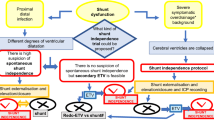Abstract
Aim
Patients with a background of cerebrospinal fluid (CSF)-diverting shunts are frequently investigated for shunt malfunction when presenting with seizures. However, there is very limited evidence in the literature regarding the association of seizures and shunt malfunction. We sought to determine the incidence of shunt malfunction in our cohort of shunted paediatric patients presenting with seizures, and the utility of seizures as a marker of shunt malfunction.
Methods
We retrospectively identified all shunted patients presenting with seizures, as well as all patients undergoing shunt revision following a presentation with seizures from our hospital database over a 14-year period from 2009 to 2023. Data gathered included demographics, de novo seizures or change in pattern of seizures, the aetiology of hydrocephalus and the segment of shunt requiring revision. Exclusion criteria included infected cases requiring shunt externalisation. A literature review of all papers discussing seizures as a presentation of shunt malfunction was also carried out.
Results
Overall, over a 14-year period of study, 338 shunted patients presented with seizures and were referred as suspected shunt malfunction with 10 having confirmed shunt malfunction requiring revision (2.9%). This group represented 6.2% of 161 cases of shunt revision carried out during the 14-year period of study. Post-haemorrhagic hydrocephalus secondary to prematurity was the commonest aetiology of shunted hydrocephalus presenting with seizures. Out of 10 patients presenting with seizures with shunt malfunction, 4 presented with de novo seizures, while 6 presented with a change in seizure pattern or frequency in already known epileptic patients. Shunt revision surgeries included 5 distal catheter, 2 proximal catheter, 1 proximal catheter-valve, 1 valve only and 1 case of whole shunt change.
Conclusion
Our data supports that seizures are rare manifestation of shunt malfunction and can present either de novo or with a change in seizure frequency in already-known epileptic patients.

Similar content being viewed by others
Data availability
No datasets were generated or analysed during the current study.
Abbreviations
- CSF:
-
Cerebrospinal fluid
- EEG:
-
Electroencephalography
- IVH:
-
Intraventricular haemorrhage
References
Cohen A, Agarwal R, Farooqi A, Kannikeswaran N (2018) Is shunt evaluation useful in children with intraventricular shunts with seizures? Pediatr Neurol. https://doi.org/10.1016/j.pediatrneurol.2018.08.005
Hack CH, Enrile BG, Donat JF, Kosnik E (1990) Seizures in relation to shunt dysfunction in children with meningomyelocele. J Pediatr. https://doi.org/10.1016/S0022-3476(05)81645-2
Faillace WJ, Canady AI (1990) Cerebrospinal fluid shunt malfunction signaled by new or recurrent seizures. Child’s Nerv Syst. https://doi.org/10.1007/BF00262265
Bourgeois M et al (1999) Epilepsy in children with shunted hydrocephalus. J Neurosurg. https://doi.org/10.3171/jns.1999.90.2.0274
Sekhar LN, Moossy J, Guthkelch AN (2009) Malfunctioning ventriculoperitoneal shunts. J Neurosurg. https://doi.org/10.3171/jns.1982.56.3.0411
Johnson DL, Conry J, Donnellc RO (1996) Epileptic seizure as a sign of cerebrospinal fluid shunt malfunction. Pediatr Neurosurg. https://doi.org/10.1159/000121043
Hosking GP (1974) Fits in hydrocephalic children. Arch Dis Child. https://doi.org/10.1136/adc.49.8.633
Lan CC, Wong TT, Chen SJ, Liang ML, Tang RB (2003) Early diagnosis of ventriculoperitoneal shunt infections and malfunctions in children with hydrocephalus. J Microbiol Immunol Infect 36(1):47–50
Graebner RW, Celesia GG (1973) EEG findings in hydrocephalus and their relation to shunting procedures. Electroencephalogr Clin Neurophysiol. https://doi.org/10.1016/0013-4694(73)90028-X
Nasser M, Sheikh Z (2022) Role of EEG in the diagnosis of spells of elevated intracranial pressure. Neurology. https://doi.org/10.1212/WNL.98.18Supplement.3141
Author information
Authors and Affiliations
Contributions
Aimee Goel has been involved in data collection, analysis and drafted the manuscript. Vesta Najmi, Katie Herbert, Amy Drew have been involved in data collection. Desiderio Rodrigues has been involved in editing the manuscript. Fardad Afshari has been involved in data collection, analysis and drafting the manuscript and supervising the project.
Corresponding author
Ethics declarations
Conflict of interest
The authors declare no competing interests.
Additional information
Publisher's Note
Springer Nature remains neutral with regard to jurisdictional claims in published maps and institutional affiliations.
Rights and permissions
Springer Nature or its licensor (e.g. a society or other partner) holds exclusive rights to this article under a publishing agreement with the author(s) or other rightsholder(s); author self-archiving of the accepted manuscript version of this article is solely governed by the terms of such publishing agreement and applicable law.
About this article
Cite this article
Goel, A., Najmi, V.S., Herbert, K. et al. Seizures as presentation of shunt malfunction: tertiary paediatric neurosurgery experience. Childs Nerv Syst (2024). https://doi.org/10.1007/s00381-024-06388-7
Received:
Accepted:
Published:
DOI: https://doi.org/10.1007/s00381-024-06388-7




